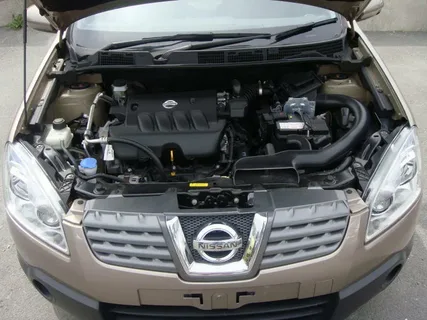The Nissan Pulsar is a compact car that has made its mark in the automotive industry for its reliability and efficiency. A crucial component that plays a significant role in the overall performance of this vehicle is the Nissan Pulsar Fuel Pump. This device ensures fuel is delivered from the tank to the engine at the appropriate pressure, facilitating optimal engine performance. In this blog post, we will delve deeper into the intricacies of the Nissan Fuel Pump, from its function to troubleshooting and maintenance tips. Understanding how fuel pump operates is essential for diagnosing potential issues that may arise.
Overview of the J10 Dualis Fuel Pump
The Dualis fuel pump is integral to the fuel delivery system in the Nissan Pulsar. It creates the necessary pressure to transport fuel from the tank to the engine’s fuel injectors. This component is typically an electric pump housed within the fuel tank for optimal efficiency and durability. Powered by a small electric motor, the pump engages when the ignition is turned on, ensuring a continuous fuel flow to the engine.
The performance of the Dualis fuel pump is critical because it directly impacts fuel flow, vehicle power output, and overall efficiency. A well-functioning fuel pump ensures that the engine receives a steady supply of fuel, which is essential for maintaining performance and fuel economy. Conversely, any decline in its performance can lead to various engine issues, such as stalling, reduced power, and poor fuel economy. Therefore, drivers need to monitor the condition of their fuel pump and address any problems immediately to prevent further damage.
Designed for both efficiency and longevity, the J10 Dualis fuel pump is built to withstand the demands of regular driving conditions. However, like any mechanical component, it is subject to wear and tear over time. Regular maintenance and prompt attention to any failure symptoms can help ensure that the fuel pump continues to operate effectively, supporting the overall performance and reliability of your Nissan Pulsar.
Common Symptoms of a Failing Fuel Pump in Nissan Pulsars
A failing fuel pump can manifest through several noticeable symptoms that can affect the performance of your Nissan Pulsar. One of the most common signs is engine stalling, where the engine may stutter or stall while driving due to insufficient fuel delivery. This interruption can be particularly dangerous in traffic or at high speeds. Another critical symptom to watch for is reduced power.
You may notice a lack of responsiveness during acceleration, indicating that the engine isn’t receiving enough fuel to perform efficiently. This can be especially evident when climbing hills or attempting to overtake other vehicles. Poor fuel economy is another red flag. If your Nissan Pulsar starts consuming more fuel than usual, it could indicate that the fuel pump is working harder than necessary to supply the engine with fuel, possibly due to wear and tear or inefficiency. A no-start condition is also indicative of fuel pump issues.
If the engine cranks but doesn’t start, the fuel pump might not supply the necessary fuel to ignite the engine. This problem can leave you stranded and should be addressed promptly. Lastly, pay attention to unusual noises emanating from the fuel tank area. A whining or buzzing sound can suggest the fuel pump is struggling to operate correctly. These sounds are often an early warning sign and should not be ignored, as they can precede more severe issues. Recognizing these symptoms early can help you take swift action to address potential fuel pump problems, ensuring your vehicle remains safe and reliable.
Diagnosing Fuel Pump Issues in Your Nissan Pulsar
If your Nissan Pulsar is experiencing issues with starting, stalling, or poor acceleration, the fuel pump could be the culprit. Here’s a guide to help you diagnose potential fuel pump problems.
1. Symptoms of a Failing Fuel Pump
A failing fuel pump can manifest in several ways. Common symptoms include difficulty starting the engine, losing power during acceleration, or stalling when the vehicle is idling. You might also notice a whining noise from the fuel tank, indicating a malfunctioning pump.
2. Check the Fuel Pump Relay and Fuse
Before delving into more complex diagnostics, inspect the fuel pump relay and fuse. These components are essential for the pump’s operation and are relatively easy to check. Refer to your vehicle’s owner manual for the location of these parts and ensure they are in good working order.
3. Listen for the Fuel Pump
Turn the ignition key to the “on” position (without starting the engine) and listen for a faint humming noise from the vehicle’s rear. This sound indicates that the fuel pump is working. If you don’t hear anything, the pump might be faulty.
4. Check Fuel Pressure
A more definitive test involves checking the fuel pressure with a gauge. Attach the indicator to the test port on the fuel rail and turn on the ignition. Compare the reading to the specifications in your vehicle’s manual. Low pressure can indicate a problem with the fuel pump or a clogged fuel filter.
5. Inspect the Fuel Filter
A clogged fuel filter can restrict fuel flow, mimicking symptoms of a bad fuel pump. Check and replace the fuel filter if it’s dirty or clogged, as this can improve fuel delivery and engine performance.
Troubleshooting Tips for Nissan Dualis Fuel Pump
The fuel pump could be the culprit if your Nissan Dualis is experiencing issues starting or stalling frequently. Common symptoms include a loss of power during acceleration, difficulty starting the engine, or whining noise from the vehicle’s rear. Observing these signs can help pinpoint whether the fuel pump is malfunctioning.
2. Check the Fuel Pump Fuse
Before diving deeper, inspect the Nissan Dualis Fuel pump fuse in the box. A blown fuse can prevent the fuel pump from operating. Replace the fuse with one of the same amperage to see if this resolves the issue. Always consult your vehicle’s manual for the exact fuse location and specifications.
3. Listen for Fuel Pump Noise
Turn the ignition key to the “ON” position without starting the engine. Listen for a humming sound from the vehicle’s rear, indicating the fuel pump is priming. If there is no sound, the pump or the relay might be faulty. In this case, you may need to test the relay or replace the fuel pump.
4. Check Fuel Pressure
Using a fuel pressure gauge, check the fuel pressure at the rail. Refer to the vehicle’s manual for the correct pressure specifications. Low pressure might indicate a failing fuel pump or a clogged fuel filter. If the pressure exceeds the recommended range, the fuel pump likely needs replacement.
5. Inspect Electrical Connections
Examine the electrical connections to the fuel pump for any loose wires or corrosion. Poor connections can lead to intermittent fuel pump operation. Ensure all connections are secure and free from damage.
Tips for Extending the Life of Your Fuel Pump
To prolong the lifespan of your Nissan fuel pump, consider these strategies:
Avoid Low Fuel Levels:
Frequently driving with a nearly empty tank can cause the fuel pump to overheat and wear out faster. Aim to keep your tank at least a quarter full to ensure adequate cooling.
Limit Short Trips:
Short drives can prevent the fuel pump from reaching its optimal operating temperature, increasing wear over time. Whenever possible, combine errands into a single trip.
Maintain Electrical Connections:
Regularly check the electrical connections associated with the fuel pump to ensure they are secure and free from corrosion. Poor connections can lead to erratic pump performance and early failure.
Monitor Engine Performance:
Pay attention to your engine’s behaviour and address any irregularities promptly. Ignoring issues like misfires or poor acceleration can strain the fuel pump more.
Choose Quality Fuel:
High-quality fuel from reputable stations helps minimize impurities that can damage the fuel pump. Avoid filling up at stations with known contamination issues.
Use Fuel Additives Carefully:
While some fuel additives can be beneficial, others may harm the fuel system. Always select additives compatible with your vehicle and follow the manufacturer’s guidelines.
Replacing Your C12 Fuel Pump
Replacing the fuel pump in your Nissan Pulsar can be straightforward using the proper preparation and tools. Here’s a step-by-step guide to help you through the process. First, ensure your safety by disconnecting the negative battery terminal to avoid electrical hazards. Next, relieve the fuel system pressure by locating the fuel pump relay in the fuse box and removing it, then start the engine to allow any remaining fuel to be used up and the pressure to drop.
Once the system is depressurized, access the fuel pump, typically in the fuel tank. You may need to remove the rear seat or access panel to reach the Nissan Pulsar. Clean the area around the fuel pump to prevent debris from entering the tank when you remove the pump. Disconnect the fuel lines and electrical connectors from the C12 fuel pump. Be careful when handling the fuel lines, as residual fuel may still exist. Use the appropriate tools to remove the retaining ring or bolts holding the pump in place.
Carefully lift the pump assembly out of the tank, not damaging the fuel sender unit or other components. Prepare the new fuel pump for installation by transferring any necessary components, such as the fuel level sensor, from the old pump. Please insert the new pump into the tank to ensure it is properly seated. Secure it with the retaining ring or bolts, and reconnect the fuel lines and electrical connectors.
Before reassembling everything, turn the ignition to the “ON” position without starting the engine to prime the new pump and check for leaks. Once confirmed, reconnect the negative battery terminal and start the engine to verify the installation’s success.
Conclusion
The condition of its fuel pump significantly influences the performance of the Nissan Pulsar. Recognizing early signs of fuel pump failure—such as engine stalling, reduced power, poor fuel economy, and unusual noises—can help prevent further damage and maintain the vehicle’s reliability. Diagnosing and addressing fuel pump issues promptly is essential, utilizing tools like fuel pressure gauges and OBD-II scanners to pinpoint problems effectively. Ultimately, the care and maintenance of the Nissan Pulsar fuel pump directly impact the vehicle’s performance and longevity.
FAQS
Q: How can I tell if my Nissan fuel pump is failing?
A: Common symptoms include engine stalling, reduced power, poor fuel economy, no-start conditions, and unusual noises from the fuel tank area.
Q: What should I do if my Nissan Pulsar fuel pump is making a whining noise?
A: A whining noise often indicates that the Nissan Pulsar fuel pump is struggling. It’s advisable to have it inspected by a professional to prevent further issues.
Q: How often should I replace the fuel filter in my Nissan Pulsar?
A: Regular fuel filter replacement is crucial for maintaining the fuel pump. Check your owner’s manual for the manufacturer’s recommended maintenance schedule, but a general rule is to replace it every 20,000 to 30,000 miles.
Q: Is it safe to drive with a failing fuel pump?
A: Driving with a failing Fuel pump is not recommended. It can lead to engine stalling, which can be dangerous, especially at high speeds or in heavy traffic.
Q: Can I replace the fuel pump, or should I seek professional help?
A: While replacing the fuel pump can be a DIY task with proper preparation and attention to safety, it’s often advisable to seek professional assistance if you’re not confident in performing the job.
| Related Business Listings |
| Contact Directory |
| Local Business Profiles |




